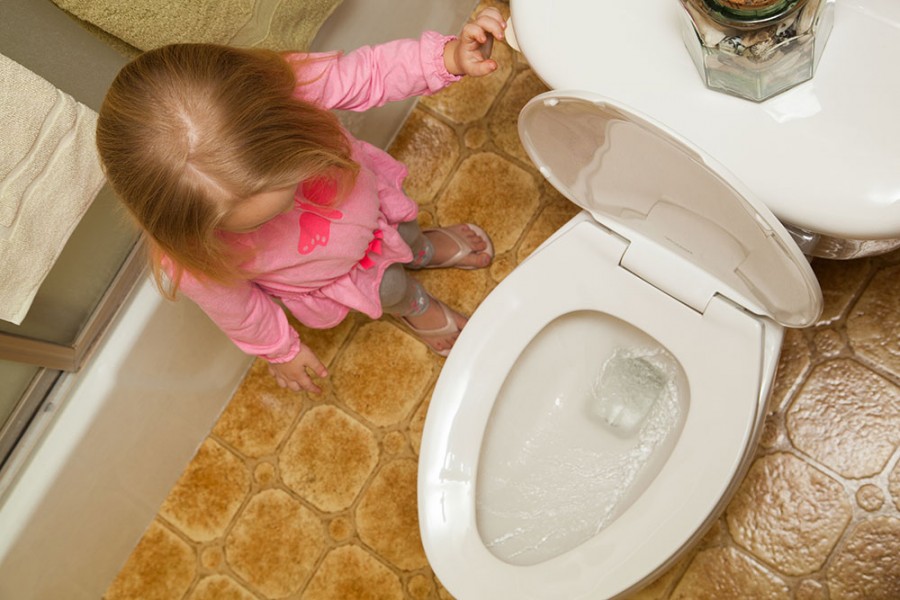Most people only think about toilets on an as-needed basis, or on those unfortunate and annoying occasions when the toilet stops working. But did you know that flushing toilets is the largest indoor use of water in California? Statewide, there are 30 million toilets and 1 million urinals. California consumes about 443 billion gallons of water a year for flushing toilets and urinals and running faucets in domestic kitchens, bathrooms and public restrooms.
Although the rain and snow has returned with this year’s El Nino, California is still in a drought and the state government continues to mandate conservation, including new toilet efficiency standards. All new toilets sold in California must now use 1.28 gallons or less per flush. In comparison, many of the older toilets still in many people’s houses use 3.5 gallons per flush or even more.
Coupled with regular attention to leaks, replacing high-flow toilets can cut per-person water use by 35 percent, estimates show. To encourage people to replace their old, water-hogging toilets, California’ Save Our Water initiative includes a High Efficiency Toilet Rebate Program that provides up to $100 towards a new high-efficiency toilet. Rebates are available to all California residents who pay a water bill and are replacing a toilet that uses more than 1.6 gallons (6 liters) of water per flush.
Robyn DiFalco, executive director of the Butte Environmental Council in Chico, has first-hand experience of upgrading to water saving toilets:
“I replaced the toilets in my house with low flow toilets a few years ago. Unfortunately, both times that we replaced them, the rebates had run out, but it was still a worthwhile change to make – the new toilets work great and make it easy to save lots of water.”
She also has some suggestions for those who can’t afford to replace their toilets or aren’t eligible for the rebate: “As an alternative, you can put a brick or a full water bottle in the toilet tank, which will displace some of the water in the tank so that less is used with each flush. Most toilets are capable of flushing with less water.”
There’s also always the time-tested drought water-saving strategy of “If it’s yellow, leave it mellow, if it’s brown, flush it down . . .”
High-efficiency toilets help cities save water and comply with water conservation mandates, but they can complicate things a bit for municipal sewage systems, as Tracy Wyhlidko, industrial waste supervisor at the City of Redding, explains: “The slope of sewer pipes is built to standards based on flow calculations for old-style toilets. In newer subdivisions where all the toilets are low-flow, there isn’t always enough water coming through the sewer pipes to keep things flowing through. To avoid blockages or backups, city workers actually have to flush out these sewer pipes more often, using city water supplies.” Despite this issue, Wyhlidko agrees that water saving toilets are a great innovation for saving water and perform just as well or better than those that use more water.
It’s important to remember (especially for people who have a domestic well at home) that every gallon of water used requires energy to pump it to where we are using it, so saving water also saves energy.
For more information on the California toilet replacement rebate program, see the Save Our Water website at: http://www.saveourwaterrebates.com/toilet-rebates.html.
Posted in: Community
Comment Policy: All viewpoints are welcome, but comments should remain relevant. Personal attacks, profanity, and aggressive behavior are not allowed. No spam, advertising, or promoting of products/services. Please, only use your real name and limit the amount of links submitted in your comment.
You Might Also Like...
San Francisco on a Budget
San Francisco abounds with hundreds of family-oriented things to do – many at no charge, or small fees. Fun for all ages, with inspiration for birthday or teen adventures, here […]

Ideas for Frugality
Ideas for Frugality Living frugally is a choice many families make to help them set goals and dream dreams that thriftiness will make financially accessible. This is a lifestyle that […]

Being Responsible Outdoors During the COVID-19 Pandemic – Frequently Asked Questions
#1 Rule: Always, always practice social distancing and follow the guidelines of your local government or the federal Centers for Disease Control (CDC), whichever are more restrictive. Unlike during and after […]
Exploring the Options for Financing Solar Panels
Perhaps you want to save money on your electricity bill. Perhaps you advocate the environmental benefits of alternative energy. Whatever your motivation, if you’re thinking about installing solar panels at […]




